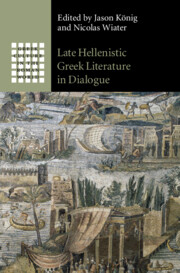Book contents
- Late Hellenistic Greek Literature in Dialogue
- Greek Culture in the Roman World
- Late Hellenistic Greek Literature in Dialogue
- Copyright page
- Contents
- Figure
- Contributors
- Preface
- Abbreviations
- Introduction
- Chapter 1 The Empire Becomes a Body
- Chapter 2 Pyrenaean Mountains and Deep-Valleyed Alps
- Chapter 3 Sailing the Sea, Sailing an Image
- Chapter 4 Ecocritical Readings in Late Hellenistic Literature
- Chapter 5 Civic and Counter-Civic Cosmopolitanism
- Chapter 6 The Wrath of the Sibyl
- Chapter 7 Imagining Belonging
- Chapter 8 Philosophical Self-Definition in Strabo’s Geography
- Chapter 9 Narrating ‘the Swarm of Possibilities’
- Chapter 10 ‘Asianist’ Style in Hellenistic Oratory and Philostratus’ Lives of the Sophists
- Chapter 11 Greek Reading Lists from Dionysius to Dio
- Chapter 12 Envoi
- References
- Index Locorum
- General Index
Chapter 1 - The Empire Becomes a Body
Power, Space and Movement in Polybius’ Histories
Published online by Cambridge University Press: 21 April 2022
- Late Hellenistic Greek Literature in Dialogue
- Greek Culture in the Roman World
- Late Hellenistic Greek Literature in Dialogue
- Copyright page
- Contents
- Figure
- Contributors
- Preface
- Abbreviations
- Introduction
- Chapter 1 The Empire Becomes a Body
- Chapter 2 Pyrenaean Mountains and Deep-Valleyed Alps
- Chapter 3 Sailing the Sea, Sailing an Image
- Chapter 4 Ecocritical Readings in Late Hellenistic Literature
- Chapter 5 Civic and Counter-Civic Cosmopolitanism
- Chapter 6 The Wrath of the Sibyl
- Chapter 7 Imagining Belonging
- Chapter 8 Philosophical Self-Definition in Strabo’s Geography
- Chapter 9 Narrating ‘the Swarm of Possibilities’
- Chapter 10 ‘Asianist’ Style in Hellenistic Oratory and Philostratus’ Lives of the Sophists
- Chapter 11 Greek Reading Lists from Dionysius to Dio
- Chapter 12 Envoi
- References
- Index Locorum
- General Index
Summary
This chapter explores how the experience of Roman power impacted Polybius’ image of the shape of the world under Roman rule. Developing further classical uses of the body as political metaphor, Polybius is the first author we know of to use the body to conceptualise the impact of Roman rule on the oikoumene. He thus foreshadows the metaphor of the corpus imperii, a core element of Roman concepts of their empire in the imperial period. This significant and innovative development was prompted, I argue, by Polybius’ experience of the nature of mid-Republican Roman power and its material representation in the cityscape of Rome. Crucial to this process is the interlinking of previously unconnected parts of the world through the expansion of Roman rule. Movement is key to this process and Polybius’ geographical ‘digression’ (3.36–9), which inscribes Hannibal’s march into a global perspective, illustrates this. Evoking archetypal representations of Roman order and control, such as milestones, itineraries and building inscriptions, Polybius’ text both exemplifies how large-scale movements interconnected different parts of the world in concrete and tangible ways and how those movements, even when initiated by Rome’s enemies, eventually resulted in the establishment of Roman power all over the inhabited world.
Keywords
- Type
- Chapter
- Information
- Late Hellenistic Greek Literature in Dialogue , pp. 36 - 68Publisher: Cambridge University PressPrint publication year: 2022



